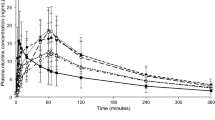Abstract
Objective: To evaluate the pharmacokinetics of a new 2-mg nicotine sublingual tablet under varying conditions of use. Methods: The pharmacokinetics of the 2-mg nicotine sublingual tablet were investigated in four separate studies involving healthy adult volunteer smokers: (1) a multiple-dose comparison with 2-mg nicotine chewing gum (n=24; 13 males, 11 females), (2) a dose-proportionality study comparing single doses of 2, 4 and 6 mg (n=21, 10 males, 11 females), (3) an evaluation of the effect of incorrect tablet use, i.e. chewing the tablet followed by either immediate or delayed swallowing (n=19, 10 males, 9 females), and (4) the effect of oral and gastric pH on nicotine absorption from the tablet (n=20; 11 males, 9 females). Study parameters were maximal plasma concentration (Cmax), time to Cmax (t max), and area under the plasma concentration–time curve (AUC). Results: The plasma nicotine profiles were similar following repeated administration of the sublingual tablet and the 2-mg nicotine chewing gum (mean Cmax 13.2 versus 14.4 ng/ml, median t max 20 versus 20 min, mean AUC11–12 12.4 versus 13.5 ng/ml per hour) with no statistically significant difference between the two treatments. The pharmacokinetics of the 4- and 6-mg doses were non-linear compared to the 2-mg dose, probably as a result of more of the dose being swallowed and undergoing first-pass metabolism in the liver. The mean Cmax for the 2-, 4- and 6-mg dose was 3.8±1.0, 6.8±2.1, and 9.0±3.3 ng/ml, respectively, and in terms of dose proportionality the relative bioavailability of the 4- and 6-mg dose was 0.82 and 0.71, respectively. Incorrect tablet use, i.e. chewing the tablet and immediate swallowing decreased nicotine bioavailability both in terms of rate and extent. Mean Cmax was 12.1 ng/ml (correct use), 10.3 ng/ml (chewing and immediate swallowing), and 12.1 ng/ml (chewing and delayed swallowing). Corresponding mean values for AUC9–10 were 11.6, 9.6 and 11.2 ng/ml per hour. There were no significant differences between 'alkaline mouth' versus control, 'acidic mouth' versus control or 'alkaline stomach' versus control, but the rate of nicotine absorption was increased at alkaline compared to acidic oral pH (mean Cmax 6.1 versus 4.9 ng/ml, P=0.003; median t max 60 versus 90 min, P=0.0002). Conclusion: The pharmacokinetic profile of the nicotine 2-mg tablet was similar to that of the 2-mg nicotine chewing gum. Absorption of nicotine from the tablet was nonlinear at higher doses (two or three tablets). Chewing the tablet and keeping the remains in the mouth or concurrent use of acidic beverages or antacids are equivalent to recommended sublingual use during normal oral pH conditions.
Similar content being viewed by others
Author information
Authors and Affiliations
Additional information
Accepted in revised form: 28 September 2000
Electronic Publication
Rights and permissions
About this article
Cite this article
Molander, L., Lunell, E. Pharmacokinetic investigation of a nicotine sublingual tablet. Eur J Clin Pharmacol 56, 813–819 (2001). https://doi.org/10.1007/s002280000223
Received:
Published:
Issue Date:
DOI: https://doi.org/10.1007/s002280000223




